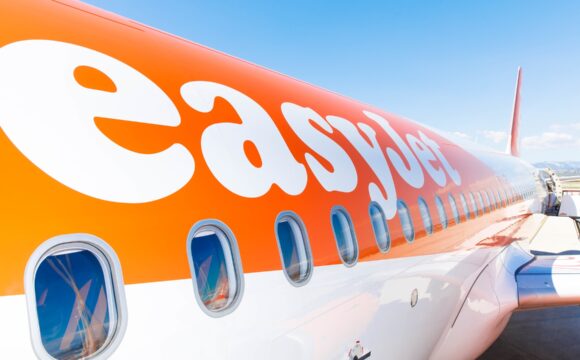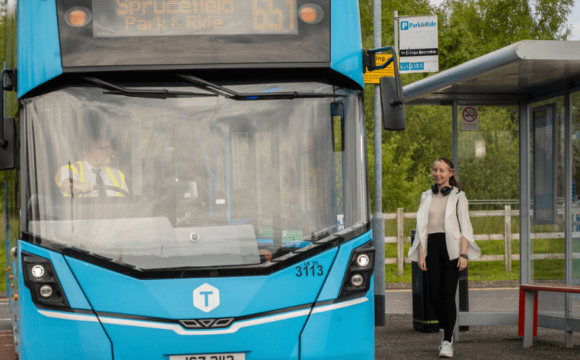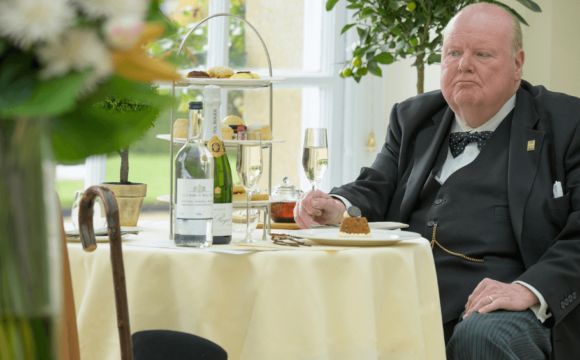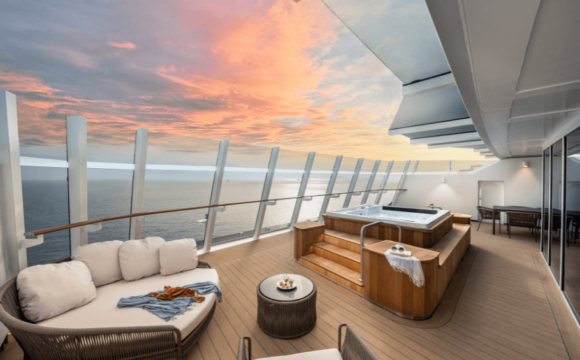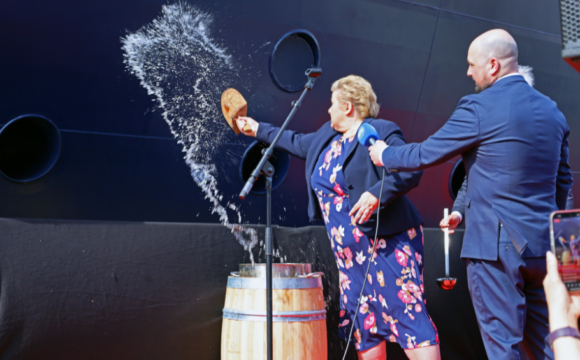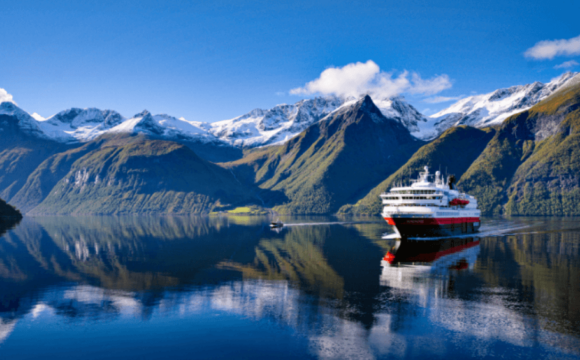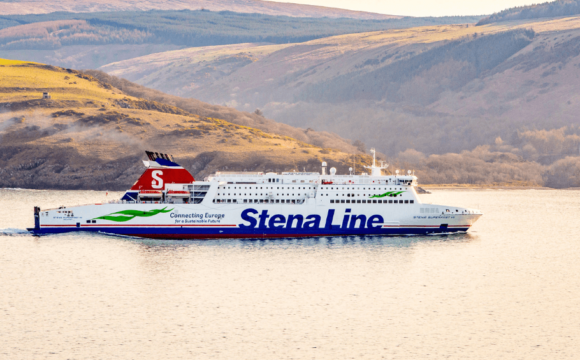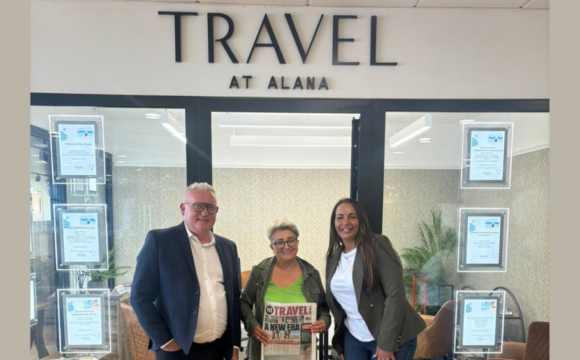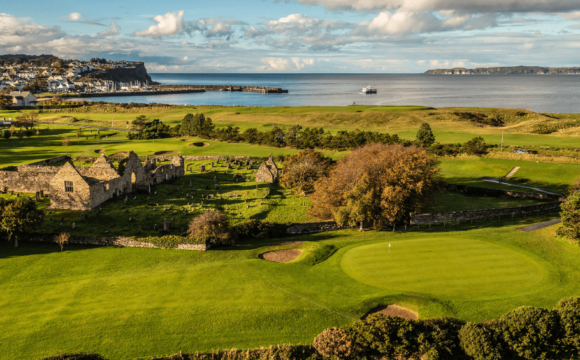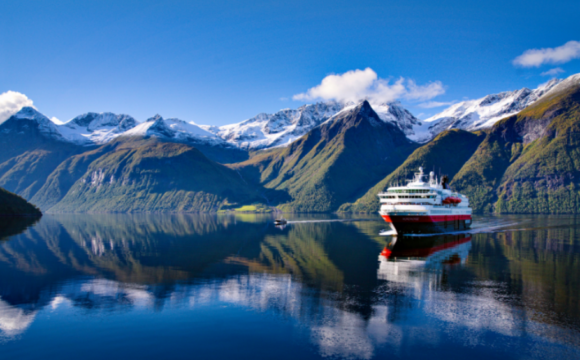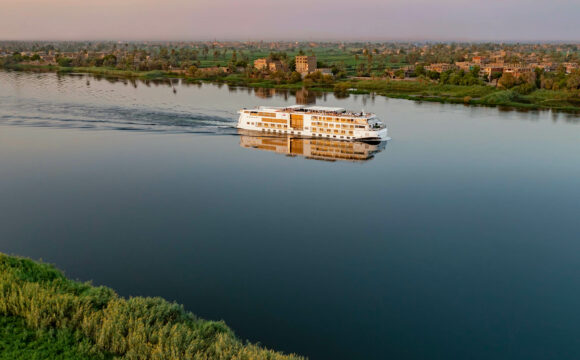By EMMA MCALLISTER & ERIN ENGLISH
emma@nitravelnews.com / erin@nitravelnews.com
EMMA
ON the 24th June 2023 Emma McAllister and Erin English from the NI Travel News team were invited by the Polish Tourism Organisation on a press trip to Krakow, Poland.
After an early start flying from Belfast International Airport, we landed in Krakow early afternoon and headed straight to our hotel, the 1891 Garni Hotel.
The 1891 Garni Hotel is located in the heart of the Jewish Quarter, where there are hints of Polish culture that hide historical secrets and showstopper attractions. The hotel combines tradition with contemporary design celebrating the rich history of the hotel itself and the local area. Located a short 17-minute walk from the main square of Krakow, it was a greatlocation for visiting key tourist attractions. After we dropped our bags off, we were greeted by Jerzy (George) who was going to be our guide to Krakow for our stay.
Jerzy started us off with a guided walking tour. One of our first stops was the “Be Happy Museum Krakow”. The Be Happy Museum is a place for everyone that enjoys taking pictures and selfies lounging in the marshmallow pool and next to the giant foam ice cream and donut sculptures. Erin and I took lots of selfies. The Be Happy Museum is great value for money if you are on a budget with a ticket price of just 50 Zloty which is £9.59 pounds sterling. If you also have time, you can also stop off at their in house Sweet Café where they serve delicious coffee and sweet treats.
Our second stop was at the the Museum of Illusions, which is located in the historical manor that was once belonged to the Potocki family. The Potocki family were a well-known Polish noble family in Poland and were once one of the wealthiest and powerful aristocratic families in Poland.
The museum showcases the polish history of the Potocki family with decorative elements dating from 19 th century, along with the modern illusion’s exhibition. We were able to walk around and interact with the illusions, staff were very accommodating in taking pictures and
explaining the illusions. Themuseum of Illusion is priced at – 55 Zloty which is £10.55 pounds sterling. Again, another good value attraction.
One of our favourite attractions was the the “Wieliczka Salt Mine”. The Salt mine is a short 20- minute drive from the centre of Krakow and is accessible by public transport. Not for the faint hearted or claustrophobic tourist, we were led down 364 steps to 100 meters underground by our wonderful tour guide, Mark On the descent into the salt mines, we were greeted with a salt statue of Nicolaus Copernicus who was well known as an astronomer, doctor, and military commander. The mines are a labyrinth of around 20 chambers displaying a variety of impressive exhibits including statues, chandeliers and art.
The story of the mines can be traced back to the legend of Saint Kinga. Saint Kinga became the patron saint of salt miners. Saint Kinga was a Hungarian princess who when she was due to marry the Polish Duke of Krakow in the 13th Century asked her father to give her a dowry of salt as this was what shethought her subjects needed. Her father gifted her one gifted her one of the richest salt mines in Maramures but this was in Transylvania. The story goes that she threw her engagement ring into the mine and when miners in Krakow started to dig the salt mines her ring and the rich salt was found. This was the start of the Wieliczka Salt Mine.
Today there is around 245km of tunnels over 9 levels and more than 2,000 chambers in the mine with a maximum depth of 327 meters, with the public only seeing 2% of the whole mine. Our guide, Mark led us deep into the mines passing through the largest underground temple which is known as St Kinga Chapel which is located 101 meters below the surface along with St Kinga Shaft, Pieskowa Skala Chamber and many more. Its definitely a must see if you are visiting Krakow.
The tour ends in a museum and shop area which you are transported to by lift. I would highly recommend a bath bomb from the gift shop. A standard ticket for the salt mine is 126 Polish
Zloty which is £24.41 pounds sterling.
To finish off our day in Krakow we took a trip to Cosmic Games. Cosmic Games is a pub in the centre of Krakow that has a UFO theme. There are over 10 different games to choose from such as beer pong, table shuffleboard, air hockey and so much more. The main attraction of the evening was the delicious cocktails. One of our particular favourites was the Farout Cocktail made with pineapple and coconut, and a cherry on top. I would highly recommend cosmic games if you were looking for a fun atmosphere with friends in Krakow.
ERIN
HAVING been to Krakow before in 2017, I was no stranger to the city’s beauty and city-break culture. On this particular trip to Krakow, I got to see a side to the city that I had never experienced before.
In recent years, Krakow has been a popular city break amongst UK and Irish holidaymakers and for good reason. The cobbled streets of Krakow’s famous market square ooze history, and in the evening the streets come alive with the vibrant cuisine and dining culture.
The second largest city, and one of the oldest cities in Poland. Krakow was the official capital of Poland from 1038 up until 1596, when the King of Poland, Sigismund III Vasa transferred the capital to Warsaw.
Upon our arrival in Krakow, we were introduced to Jerzy, our tour guide and expert on all things Krakow. Prior to this visit, I didn’t know much about the historical side of Krakow. However, there was nothing that a walking tour with Jerzy couldn’t fix and after a few hours, our brains were filled to the brim with history.
The city’s name, Krakow is said to originally derive from Krakus, the leader of the Vistulan tribe who founded the city around 700AD. Upon Krakus and the Vistulan tribes arrival, Wawel Castle was built at the top of Wawel Hill, a structure that still stands proudly over the city today. According to legend, many believe that when Krakus discovered the city, he defeated the Wawel dragon, a dragon that terrorised the citizens of the city and lived in a cave at the foot of Wawel Hill. To mark this occasion, the city was then named Krakow, in celebration of Krakus and his defeat of the Wawel dragon.
A sculpture of the Wawel Dragon sits on the banks of the river Vistula, perched just below Wawel Hill and Wawel Castle. Installed in 1972, the sculpture performs a spectacular show as it breathes fire into the air every five minutes.
Residing in the complex of Wawel Castle stands Wawel Cathedral. A magnificent gothic structure that is nearly 1000 years old, Wawel Cathedral has been the location of many notable occasions throughout Polish history. Wawel Cathedral acted as the coronation and burial site of the Polish Monarchy. The exterior of the cathedral is adorned with side-chapels and mausoleums, the most popular addition is Sigismund’s Chapel, easily recognised by its beautiful golden dome.
Hints of the myths and legends surrounding the Krakow Dragon can be identified at the entrance of the cathedral. As many believe that bone of the Wawel Dragon are hanging at the entrance of the Cathedral, and have been since the beginning of the 16th century. While it is speculated how the bones winded up at the entrance of the religious building, it is widely believed amongst locals that if the bone ever breaks or falls, the city of Krakow will cease to exist.
I would recommend a trip to Wawel Castle, a short walk from Krakow’s Old Town Market Square, the grounds of the castle are free to access and are filled with beautiful sights. Snippets of Polish history are dotted around the complex, from Wawel Castle which was the home of the Polish Monarchy, including the mighty Jagiellonian dynasty. Not to mention the Wawel Cathedral, a gothic cathedral which has been the religious foreground of many figures throughout Polish history. To access the interior of the Wawel cathedral and the castle, there is an admission fee of roughly twenty pounds per person. Not a fan of history? A trip to the top the Wawel Hill is still throughly recommended for fabulous views of the Vistula river. It’s also the perfect place to gather some stunning holiday snaps.
Walking just a short distance from Wawel Castle lies Krakow’s Old Market Square, perhaps my favourite area in the city. The architecture of the main square is visibly stunning. Despite being the centre of Krakow’s old town, the area is not overcrowded and easy to navigate. The square is bordered by bars and restaurants, not to mention an array of gift shops. The area is wonderful in the evening time, when you can stand in the heart of the main square to take in the sights of the illuminated St Mary’s Basilica and The Cloth Hall.
Perhaps the most photographed area in all of Krakow, St Mary’s Basilica is the main focus point of the city’s old own square. The construction of St Mary’s Basilica began in the late 13th century, before being rebuilt in Gothic style during the 14th century. Stepping into the Basilica, prepare to be awe-stricken by the wooden altarpiece. Known as St Mary’s altar, the piece was constructed by Veit Stoss. The altar piece stands at 80 metres tall and is sure to be a space of wide amazement. So much so that in 1978, St Mary’s Basilica and the Krakow’s main square was named as a UNESCO World Heritage Site.
After a full day of touring with Jerzy, it was time to rest up and get ready for a brand new day. Our second day of historical touring brought us into a whole new era of Polish history. A time when Poland was under the control of the Soviet Union. Waking bright and early at 1891 Garni Hotel, myself and Emma were met in the morning by Kornelia from Crazy Guides and her blue Trabant, a traditional car in Communist Poland. Poland was under the control of a communist government from 1952 until 1989. Still to this day, historic reminders of Poland’s time under communist rule still remain. Especially in the town of Nowa Huta, a small town located around a twenty minute drive from Krakow’s Old Town.
Nowa Huta was created as a industrial city just a short distance from Krakow after World War Two. Translating to New Steelworks in English, Nowa Huta was built to become the city for the workers of the Lenin Steelworks, which opened in 1954. Nowa Huta was meant to become an ideal setting for the communist structure, where residents could live and work. The architecture and street structure of Nowa Huta resembles Paris, with a radial city plan where all five avenues directed towards the Central Square. The Architecture throughout Nowa Huta is Socialist Realism and the city was clearly built to be the ideal model of a communist town. Although as the years progressed, Nowa Huta became a place of revolution against the Soviet Union.
Our first visit on the tour was the Avenue of the Roses where a 6.5 metre statue of Vladimir Lenin, the first leader of the Soviet Union and the leader of the revolutionary Bolsheviks, once stood. Initially erected in 1973, the statue was contested by locals and Kornelia informed us how there was one successful attempt to damage the statue of Lenin. In 1979, an explosive was placed on the statue’s foot and Lenin’s toe was destroyed. While the damage to the statue was limited, this was viewed as a massive success for Nowa Huta residents and the anonymous perpetrator was looked at upon a hero. Following the collapse of the Soviet Union, the statue of Lenin was pulled down by residents in 1989. Interestingly, the damaged statue now stands in a Swedish theme park.
The next stop on our communist tour was the Tadeusz Sendzimir Steelworks, formerly named the Vladimir Lenin Steelworks. At the height of the 1970’s, the steelworks factory employed around 40,000 people who all resided in Nowa Huta and produced around 7 million tons of steel. In the 1980’s, the steelworks factory became a centre point for the anticommunist resistance in Nowa Huta. Numerous anticommunist strikes and demonstrations took place at the factory. Then it was time to head underground, at the entrance of the factory, two administration buildings stand opposite each other. Hidden beneath one of these buildings is an entire underground bunker. The Soviets were fearful of a nuclear attack from the west and the bunker was built to protect important Soviet figures in Nowa Huta. Other bunkers are dotted across the city for residents.
Visiting these bunkers is like stepping back in time. Maps of Nowa Huta and the factory remain on tables, as well as calendars and other workplace items. The bunker remains untouched from outside elements, and a visit is truly like stepping back into Communist Nowa Huta.
Our Nowa Huta tour came to an end in Style Restaurant, a Nowa Huta diner which has been a staple to residents from the communist-era until modern day. At Style, we were able to enjoy some cheese and potato dumplings and sip at four traditional Polish Vodkas.
Nowa Huta was the highlight of my trip, from getting picked up in a vintage car to touring the underground bunker. Not to mention the tipple of treats at the end!


